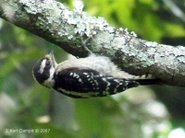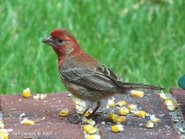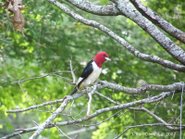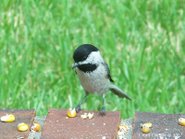I finally broke down and decided to purchase a feeder from Wild Birds Unlimited. They have a pole system that puts the stop to squirrel problems. I had one and now, I don't!!!
Not that I dislike squirrels but I would rather feed the birds and not the squirrels. Squirrels also take up space on the feeder and prevent the birds from feeding. Below is my setup and believe, it works!
The feeder setup also has perches that allow birds to feel protected before feeding. I noticed that a Brown Thrasher family likes the perches. The adult had two juveniles waiting while it picked at the suet on the side of the feeder.
As you can see, the juveniles are well on their way on catching up to their parent. They look very similar to the adult in almost every way. However, they haven't yet developed the yellow eye which helps to identify the adult.
I've also found a Brown Thrasher nest we two eggs. I can't get close enough long enough to get any shots but I've got more juveniles on the way.
Good Birding and God Bless!
Saturday, May 31, 2008
Business Has Picked Up!!!
Tuesday, May 20, 2008
Red-Headed Acrobatics!
I've recently added several Red-Headed Woodpeckers to my regulars in my backyard. They were scarce during the winter except for one juvenile that stayed pretty high up in the trees and was only rarely seen.
One of the new visitors has taken a liking to the peanut feeder. He performs acrobatics to get to the peanuts in the feeder. He spins around and around at the bottom to peck at the peanuts.
We spent the weekend at Brush Mountain with my wife's brother and his wife. It was a great time of birding for me. I added three birds to my life list!
My brother-in-law and I spotted a Blue-Gray Gnatcatcher right off the bat the first day I was there. It was a lifer for the both of us! I got a few pictures of it but none turned out. Maybe next time!
On Saturday, we hiked up Pinnacle Mountain in West Little Rock. We saw another lifer five minutes into our hike. It was a Black & White Warbler. He was flitting about in the trees and was too quick to get any pictures.
I added one more to my list on Saturday evening which was a Bank Swallow. He was flying around a lake near the house. He was flying acrobatically and catching insects for dinner.
Good Birding and God Bless!
Sunday, May 11, 2008
And The Winner Is . . . Robin Red-Breast!!!
I have had my first juvenile visitors of the year. I was wondering what species would get off to the early start. It turned out to be Robins. They won the "First Juvenile Of The Year" title for 2008.
The juveniles look very similar to the adults except the rusty red breast isn't fully developed. You can see the slight rusty red color on the juveniles but it is speckled with grayish black spots.
It also amazes me how quickly the juveniles grow. These pictures were actually taken early last week. You can see they are slightly smaller than the adult carefully watching over them.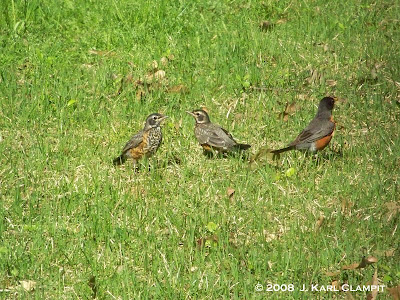
I also was able to capture these videos which I wanted to include. The adult is feeding the juveniles as they follow it around. I just love to see the interaction between the adult and the juvenile as they raise them!
Below is the newest picture of one of the juveniles. They were taken yesterday. As you can see, it is as big as the adult. They just grow up so fast!

Have you seen any juveniles this year? What kind were they?
Good Birding and God Bless!
Thursday, May 8, 2008
Cornell Lab: Workshop Fine-Tunes the Passion for Sound
God Bless and Good Birding! - Karl
Workshop Fine - Tunes the Passion for Sound
Ithaca, NY From June 7 to 14, the annual Sound Recording Workshop offered by the Cornell Lab of Ornithology returns to San Francisco State University’s Sierra Nevada Field Campus in the spectacular surroundings of the eastern foothills of California’s northern Sierra Nevada mountains. Participants learn state-of-the-art techniques for capturing bird sounds, guided by experts.
Learn to capture the sounds of wildlife through lecture, discussion, and daily field recording sessions participants learn how to effectively handle a portable field recording system to make scientifically accurate recordings of bird vocalizations. Participants learn how to conquer wind, how a roadbed can help overcome the sound of a rushing stream, and why placing a microphone on the ground is sometimes the best strategy. There is also an introduction to the science of sound analysis which converts sound waves into visual images called spectrograms. With signal analysis it’s possible to visualize a bird song note by note.
The Sound Recording Workshop fee of $895 covers tuition, class materials, ground transportation, food, and lodging. A $100 deposit is requested to reserve a space, which is limited to 20 students. Registration and payment are due by May 31.
Learn more at:
http://www.birds.cornell.edu/macaulaylibrary/Contribute/soundRecordingWorkshop.html or contact Tammy Bishop at (607) 254-2198 or macaulaylibrary@cornell.edu.
#
The Cornell Lab of Ornithology is a membership institution dedicated to interpreting and conserving the earth’s biological diversity through research, education, and citizen science focused on birds. Visit the Lab’s web site at http://www.birds.cornell.edu .
Thursday, May 1, 2008
Rose Breasted Grosbeak Migrants
If there is one thing I've learned about watching birds, sometimes you get lucky and just happen to be in the right place at the right time. I've seen several birds for just a second and then they are gone. Sometimes, never to return.
This was the case (or so I thought) on Sunday when this one flew into the yard. I was able to get a quick shot off before it flew off. I quickly got out my trusty field guides to determine which one it was. At first glance, I thought that it was a female Purple Finch, but then realized it was way too big.
I was able to surmise that is was a female and a Rose Breasted Grosbeak. Wow, another addition to my life list. They seem to be coming quickly as the spring migration has a lot of birds moving!
I like to capture pictures of the female of the species and really enjoy attempting to identify them. They usually don't have the distinguishing marks that easily identify the males.
Another thing I like about seeing the female is that you know the male is not far behind! This was the case with the Rose Breasted Grosbeak. The male didn't show back up on Sunday, but made his debut on Monday! He is a very nice looking bird.
It took these guys a little while to find out which feeder to use and where to find food. I had to fill up my tray feeder with seeds as they had a little trouble negotiating the smaller tube and house feeders.
Good Birding and God Bless!




